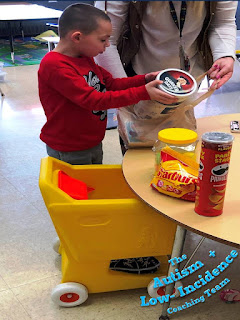When to use Sensory Breaks:
- Use Sensory Breaks when the data indicates Sensory is the function of behavior or when Sensory testing indicates the need for sensory breaks
- Not sure if you should try Sensory Breaks? Check out this chart to see if it describes the student you are trying to support!
When to schedule Sensory Breaks?
- Best approach - Proactively scheduled
- Don’t wait until the student is showing signs of escalation or is in a meltdown or crisis, you’ve waited too long!
- You need to proactively implement Sensory Breaks to help the student maintain regulation across the school day.
- Should not be contingent upon behavior or work completion. Sensory breaks should be viewed as important as time spent on academics. Promoting and maintaining self-regulation throughout the school day provides the student the opportunity to focus and learn.
- Generally speaking, all students may benefit from one sensory break in the morning and one in the afternoon.
- However, this needs to be individualized based on data the team collects when sensory breaks are taken.
- Frequency and duration may be increased based on individual student needs.
How do I know if the Sensory Break was effective?
- Participation in sensory breaks should result in students feeling/appearing calmer and more regulated.
- There should be targeted supports being used during sensory breaks that are intended for each student taking a sensory break.
- Keep data! Track the schedule, frequency and duration of Sensory Breaks. Note what supports or equipment is being used – was it helpful, why or why not? Analyzing the data you keep will help determine changes that may need to be made to the student’s Sensory Break schedule.
Examples of Sensory Break locations:
Classroom:
 |
| Example of a calming area within a classroom where students had alternative seating options, fidgets, preferred books, etc Nikki Timmerman Kleptz ELC, Northmont |
Hallway:
 |
| Example of a clearly defined hallway exercise routine for students to complete before returning back to class. JFK Elementary, Kettering |
 |
| Example of “locker shopping” while taking a purposeful walk in the hallway. Then the student had to unload his purchases and bag them up! Heidi Horner Miami County ESC |
Separate Location:
 |
| Sometimes having an assigned job or duty is a great way to embed sensory input while being helpful at school. |
 |
| Kelly Moberly Learning Center-East, MCESC |
 |
| Wayne High School, Huber Heights |
Sensory Rooms:
Sometimes pairing an active motor sensory break with a purposeful activity helps slow students down and helps them get the input they need to help calm and organize their nervous systems!
Calming sensory rooms can be a great option for escaping the sensory-rich environment of the classroom and have the opportunity to take a break in a quiet, dimly lit location with a variety of supports such as alternative seating options, calming music, lighting options, weighted supports, fidgets, etc.
Sometimes pairing an active motor sensory break with a purposeful activity helps slow students down and helps them get the input they need to help calm and organize their nervous systems!
 |
| Katie Mlod Mad River ECC- Mad River |
Calming sensory rooms can be a great option for escaping the sensory-rich environment of the classroom and have the opportunity to take a break in a quiet, dimly lit location with a variety of supports such as alternative seating options, calming music, lighting options, weighted supports, fidgets, etc.
 |
| Beavertown Elementary, Kettering |
 |
| Smith Elementary, Oakwood |
Interested in implementing Sensory Breaks but just don’t know where to start?
- Consult the Occupational Therapy staff in your building – they’re a wealth of information and will be able to help direct you to the supports you may need to help support your students!







No comments:
Post a Comment